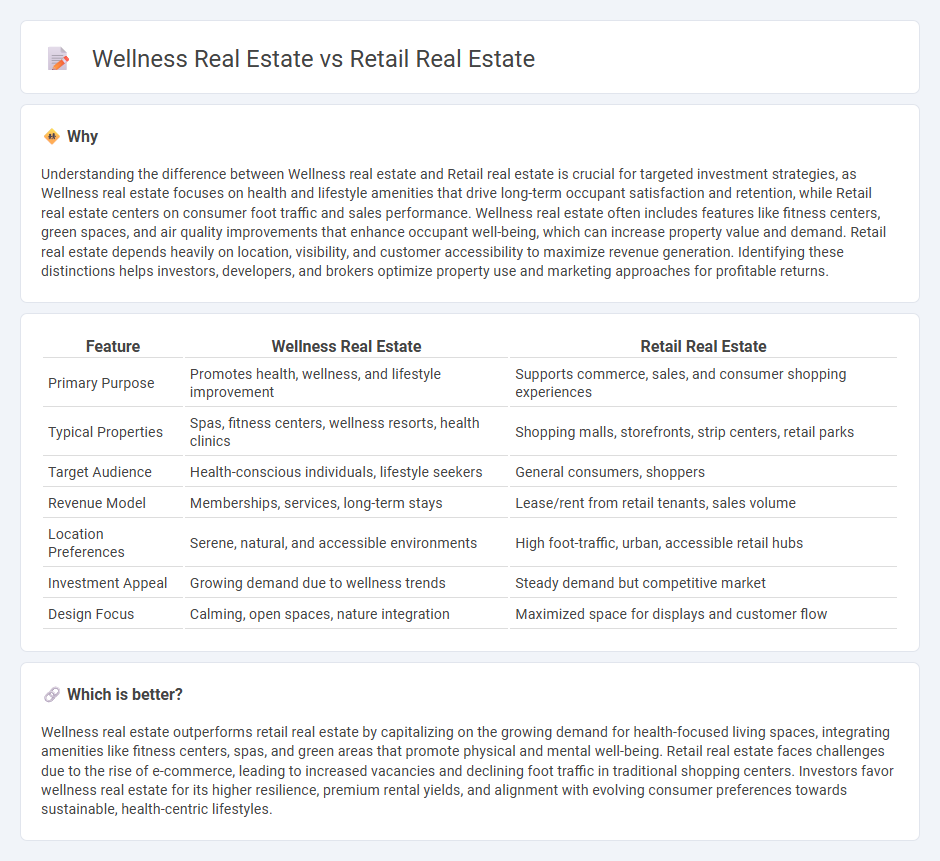
Wellness real estate focuses on properties designed to enhance health and well-being through features like green spaces, fitness centers, and sustainable materials, appealing to health-conscious buyers and investors. Retail real estate centers on commercial spaces such as shopping centers, malls, and storefronts aimed at maximizing consumer foot traffic and sales revenue. Explore the unique benefits and investment opportunities within both sectors to better understand their market potential.
Why it is important
Understanding the difference between Wellness real estate and Retail real estate is crucial for targeted investment strategies, as Wellness real estate focuses on health and lifestyle amenities that drive long-term occupant satisfaction and retention, while Retail real estate centers on consumer foot traffic and sales performance. Wellness real estate often includes features like fitness centers, green spaces, and air quality improvements that enhance occupant well-being, which can increase property value and demand. Retail real estate depends heavily on location, visibility, and customer accessibility to maximize revenue generation. Identifying these distinctions helps investors, developers, and brokers optimize property use and marketing approaches for profitable returns.
Comparison Table
| Feature | Wellness Real Estate | Retail Real Estate |
|---|---|---|
| Primary Purpose | Promotes health, wellness, and lifestyle improvement | Supports commerce, sales, and consumer shopping experiences |
| Typical Properties | Spas, fitness centers, wellness resorts, health clinics | Shopping malls, storefronts, strip centers, retail parks |
| Target Audience | Health-conscious individuals, lifestyle seekers | General consumers, shoppers |
| Revenue Model | Memberships, services, long-term stays | Lease/rent from retail tenants, sales volume |
| Location Preferences | Serene, natural, and accessible environments | High foot-traffic, urban, accessible retail hubs |
| Investment Appeal | Growing demand due to wellness trends | Steady demand but competitive market |
| Design Focus | Calming, open spaces, nature integration | Maximized space for displays and customer flow |
Which is better?
Wellness real estate outperforms retail real estate by capitalizing on the growing demand for health-focused living spaces, integrating amenities like fitness centers, spas, and green areas that promote physical and mental well-being. Retail real estate faces challenges due to the rise of e-commerce, leading to increased vacancies and declining foot traffic in traditional shopping centers. Investors favor wellness real estate for its higher resilience, premium rental yields, and alignment with evolving consumer preferences towards sustainable, health-centric lifestyles.
Connection
Wellness real estate and retail real estate are connected through the integration of health-focused amenities and services within commercial shopping spaces, enhancing consumer experience and driving foot traffic. Retail real estate projects increasingly incorporate wellness centers, spas, and fitness facilities to attract health-conscious tenants and customers, creating synergistic value. This convergence boosts property desirability, promotes longer visitation times, and supports lifestyle-oriented retail strategies.
Key Terms
Tenant Mix
Retail real estate typically features a tenant mix composed of apparel stores, restaurants, and entertainment venues aimed at attracting high foot traffic and diverse consumer spending. Wellness real estate prioritizes tenants such as fitness centers, medical clinics, holistic health providers, and spas that cater to health-conscious individuals seeking preventive care and lifestyle improvement. Explore the evolving tenant mix in each sector to understand investment and development opportunities.
Foot Traffic
Foot traffic density in retail real estate significantly drives tenant revenue, with prime locations often reaching 10,000+ visitors daily, coupled with high visibility and accessibility boosting sales. Wellness real estate sees targeted foot traffic focused on health-conscious demographics, often featuring integrated amenities like yoga studios, spas, and nutrition centers to enhance occupant well-being and engagement. Explore how strategic foot traffic patterns influence investment potential and tenant satisfaction in both sectors.
Amenities
Retail real estate prioritizes amenities such as high foot traffic areas, ample parking, and visible storefronts to attract consumers and drive sales. Wellness real estate emphasizes features like fitness centers, spa facilities, green spaces, and air quality enhancements designed to promote health and well-being. Explore the distinct amenity strategies shaping the future of retail and wellness property investments.
Source and External Links
Retail Real Estate - An Investor's Industry Overview - Retail real estate includes establishments that develop shopping and entertainment properties, with demand driven by factors like consumer spending, location visibility, and metrics such as sales per square foot and foot traffic.
Retail Properties - The retail real estate market is recovering to pre-pandemic levels, with high demand and tight supply, and flexible leasing and investor interest are key trends in the sector.
Retail Real Estate 101: 6 Questions and Answers - Retail real estate mainly consists of malls, lifestyle centers, and factory outlets, each varying in size and tenant mix, serving as locations for marketing and selling consumer goods and services.
 dowidth.com
dowidth.com